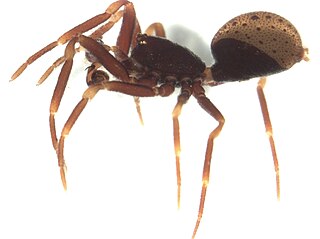
Linyphiidae, spiders commonly known as sheet weavers, or money spiders is a family of very small spiders comprising 4706 described species in 620 genera worldwide. This makes Linyphiidae the second largest family of spiders after the Salticidae. The family is poorly understood due to their small body size and wide distribution; new genera and species are still being discovered throughout the world. The newest such genus is Himalafurca from Nepal, formally described in April 2021 by Tanasevitch. Since it is so difficult to identify such tiny spiders, there are regular changes in taxonomy as species are combined or divided.

Velvet spiders are a small group of spiders almost entirely limited to the Old World, with the exception of one species known from Brazil. In Europe, some are commonly called the ladybird spiders.
Nanoa is a sister genus of Pimoa, in the spider family Pimoidae, containing the single species Nanoa enana.

Archaeidae, also known as assassin spiders and pelican spiders, is a spider family with about ninety described species in five genera. It contains small spiders, ranging from 2 to 8 millimetres long, that prey exclusively on other spiders. They are unusual in that they have "necks", ranging from long and slender to short and thick. The name "pelican spider" refers to these elongated jaws and necks used to catch their prey. Living species of Archaeidae occur in South Africa, Madagascar and Australia, with the sister family Mecysmaucheniidae occurring in southern South America and New Zealand.
Eriauchenus is a genus of East African assassin spiders first described by O. Pickard-Cambridge in 1881. The genus name has been incorrectly spelt "Eriauchenius".
Tomobella is a genus of Malagasy jumping spiders that was first described by T. Szűts & N. Scharff in 2009. As of August 2019 it contains only two species, found only on Madagascar: T. andasibe and T. fotsy.
Afroneta is a genus of dwarf spiders that was first described by Å. Holm in 1968.
Synotaxus is a genus of araneomorph spiders in the family Synotaxidae that was first described by Eugène Louis Simon in 1895. Originally placed with the tangle web spiders, it was moved to the family Synotaxidae in 2017.
Cyrtobill is a genus of Australian orb-weaver spiders containing the single species, Cyrtobill darwini. It was first described by V. W. Framenau & N. Scharff in 2009, and has only been found in Australia.
Erigonops is a monotypic genus of African dwarf spiders containing the single species, Erigonops littoralis. It was first described by N. Scharff in 1990, and has only been found in South Africa.
Holmelgonia is a genus of African dwarf spiders that was first described by R. Jocqué & N. Scharff in 2007.
Mecynidis is a genus of African dwarf spiders that was first described by Eugène Louis Simon in 1894. Originally placed with the tangle-web spiders, it was moved to the Linyphiidae in 1964.
Pecado is a monotypic genus of dwarf spiders containing the single species, Pecado impudicus. It was first described by G. Hormiga & N. Scharff in 2005, and has only been found in Spain, Morocco, and Algeria.
Ulugurella is a monotypic genus of Tanzanian sheet weavers containing the single species, Ulugurella longimana. It was first described by R. Jocqué & N. Scharff in 1986, and is only found in Tanzania.
Tomomingi is a genus of African jumping spiders that was first described by T. Szűts & N. Scharff in 2009.

Madagascarchaea is a genus of assassin spiders first described by H. M. Wood & N. Scharff in 2018.

Cyrtarachninae is a subfamily of spiders in the family Araneidae. The group has been circumscribed in several different ways. It originated as the group Cyrtarachneae, described by Eugène Simon in 1892. The group was later treated at different ranks: as a tribe, both under Simon's name and as Cyrtarachnini, and as the subfamily Cyrtarachninae. Circumscriptions have varied. The broadest circumscription, Cyrtarachninae sensu lato (s.l.), includes three of Simon's original groups, including the bolas spiders. Unlike most araneids, members of the subfamily do not construct orb webs, some not using webs at all to capture prey, some using one or more sticky drops on a single line, while others construct webs with few widely spaced non-spiral threads, some triangular. Many have been shown to attract prey by producing analogues of insect sex pheromones, particularly to attract male moths. Adult females may mimic snails, bird droppings and other objects, and so are able to remain exposed during the day time, capturing prey at night.

Tingotingo is a genus of Polynesian shield spiders. It was first described by Gustavo Hormiga and N. Scharff in 2020, and it has only been found in New Zealand.

Whakamoke is a genus of Polynesian shield spiders. It was first described by Gustavo Hormiga and N. Scharff in 2020, and it has only been found in New Zealand.

Stenaelurillus nigricaudus, synonyms Aelurillus sahariensis and Stenaelurillus nigritarsis, is the type species of the genus Stenaelurillus. It is a jumping spider that lives in Algeria, Burkina Faso, Gambia, Mali, Niger and Senegal. The male was first described by Eugène Simon in 1886 and the female initially in 1936 by Ludovico di Caporiacco and more thoroughly by Nikolaj Scharff and Tamás Szűts in 2005. It is a medium-sized spider with a cephalothorax between 2.4 and 2.7 mm and an abdomen that is between 2 and 3.7 in long. The carapace is reddish-brown and has two white or yellow stripes. The female abdomen has a pattern of stripes and spots, with some examples having brown spots inside yellow spots. The male abdomen has either a single dark stripe or two white and one brown stripes. While the female pedipalps are yellow, the male has either dark or brown pedipalps. The female has distinctive flanges at its copulatory openings. The male is distinguished by the shape of its palpal bulb and, particularly, of its hook-shaped embolus.







